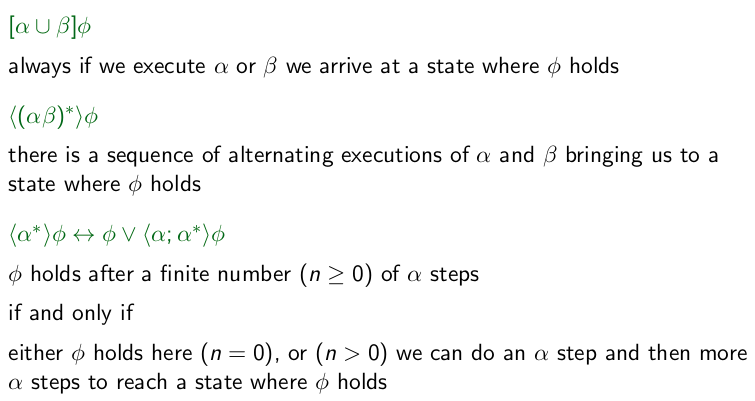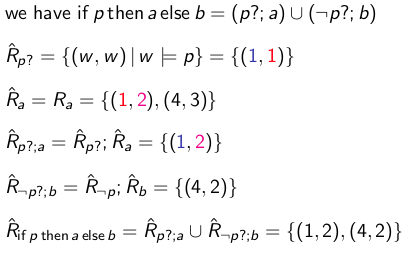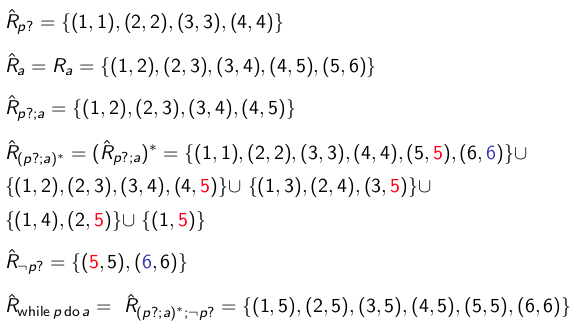Advanced Logic
Table of Contents
Propositional dynamic logic (PDL)
In propositional dynamic logic (PDL), aim to prove: φ → [while σ do α] ψ
- i.e. starting with φ true, for any terminating execution of the program, we have ψ true.
Definitions:
- state of program execution: state/world
- program: regular program which slightly generalizes a while program
- statement {pre}program{post}: formula pre → [program] post
For every program α we have modality 〈α〉:
- 〈α〉φ: it’s possible to execute α from current state, and successfully halt in state satisfying φ (like existential quantification)
- [α]φ: for all executions of α, if α successfully halts, then it halts in a state satisfying φ (like universal quantification)
Program definitions:
- a: program from set A of atomic programs (letters, like in prop. logic)
- α; β: sequential composition
- α ∪ β: non-deterministic choice
- α*: iteration, 0 or more times.
- φ?: test, depends on the grammar for formulas
- if φ then continue without changing state, if not then block without halting
Examples of formulas:

We obtain semantics of PDL as instance of multi-modal logic.
Operators:
- composition “R;S” = {(x, z) | ∃ y : Rxy ∧ Syz}
- union “R ∪ S” = {(x, y) | Rxy ∨ Sxy}
- R*: repeat R one or more times
A model M is a PDL-model if the frame is a PDL-frame and $R_{\phi ?} = \{ (w,w) \;|\; M, w \models \phi\}$
The R of the frame is all sets of Rₐ where a is a program (i.e. a label on an arrow).
Proof example of 〈α, β〉 p → 〈α〉〈β〉p
- Take a PDL model and a state x.
- Assume x ⊨ 〈α, β〉 p
- That is, there is a state y such that $(x, y) \in R_{\alpha;\beta}$ and y ⊨ p.
- $R_{\alpha;\beta} = R_{\alpha}; R_{\beta}$
- That is, there is a state u such that $(x, u) \in R_{\alpha}$ and $(u,y) \in R_{\beta}$.
- Because $(u,y) ∈ R_{\beta}$ and y ⊨ p, we have u ⊨ 〈β〉 p
- Because $(x,u) ∈ R_{\alpha}$, we have and u ⊨ 〈β〉p we have x ⊨ 〈α〉〈β〉p.
If then else:
- program:
if p then a else b - encoding: (p?; a) ∪ (¬ p? ; b)
Example
Graphviz code
digraph g {
rankdir=LR
1 [xlabel="[p]"]
1 -> 2 [label="a"]
4 -> 2 [label="b"]
1 -> 3 [label="b"]
4 -> 3 [label="a"]
}
Calculate the relation for if p then a else b, which is encoded as (p?; a) ∪ (¬ p?; b):

While:
- program:
while p do a - encoding: (p?; a)*; ¬ p?
Example
Graphviz code
digraph g {
rankdir=LR
1 -> 2 [label="a"]
2 -> 3 [label="a"]
3 -> 4 [label="a"]
4 -> 5 [label="a"]
5 -> 6 [label="a"]
1 [xlabel="[p]"]
2 [xlabel="[p]"]
3 [xlabel="[p]"]
4 [xlabel="[p]"]
}
Calculating the relation while p do a, encoded as (p?; a)*; ¬ p?:

If E is a bisimulation between two A-models, then it is a bisimulation for the models’ PDL-extensions. However, intersection and inverse are not safe for bisimulation.